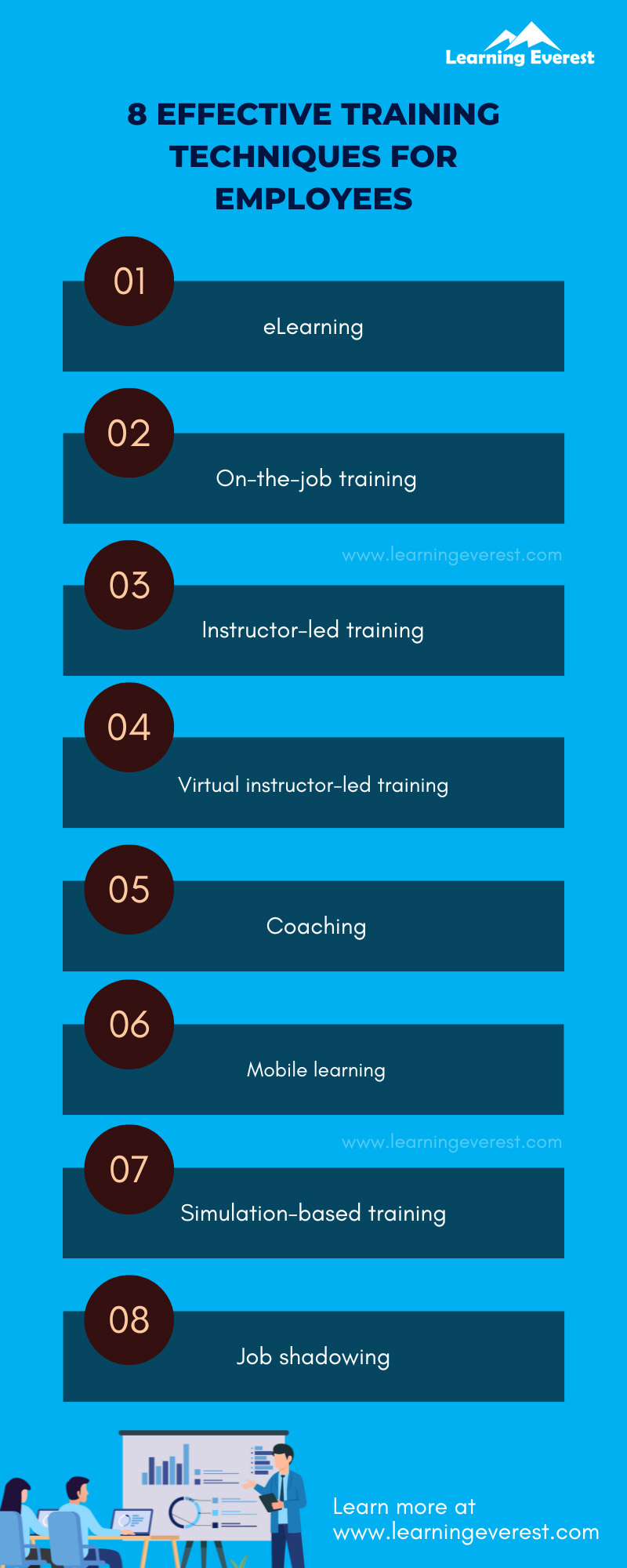When developing training interventions for employees, you can choose from many training techniques for employees. Picking the right training technique is crucial for building effective training programs as aligning the training medium with the training topic leads to better learning. This article will introduce you to 8 effective training techniques for employees you can use for your training programs.
Table of Contents
Training Techniques for Employees
To pick the right training technique, you will first need to carefully consider factors like training needs and context, training budget, size of learner group, your training resources and capacity, and whether your learners will be remote or physically available. Based on these factors, you can pick the appropriate training technique out of the multiple available formats.
eLearning
eLearning is one of the most widely used training techniques for employees. eLearning refers to any learning that is delivered asynchronously via an electronic medium, i.e., a mobile, PC, or tablet. eLearning is highly convenient and accessible, allowing employees to learn anytime and anywhere. It is also versatile in the kind of training delivery formats it offers, ranging from simple text-based learning to immersive video-based courses and gamified learning. Once developed, eLearning also reduces the demands on your L&D teams as its deployment and tracking can be automated using an LMS, making it a highly scalable training technique for employees.
On-the-job training
On-the-job training, as the name suggests, takes place on the job. It’s a training technique that enables employees to learn in the flow of work, eliminating the need for carving out specific slots for learning. It is a highly effective training technique for employees as it creates hands-on learning opportunities that are relevant to learners’ job tasks. In on-the-job training, learners pick up knowledge and skills by doing, such as participating in a project, working on a new software, or implementing a new process. There is a lesser emphasis on imparting theoretical information and a greater focus on creating meaningful practical opportunities.
Instructor-led training
Instructor-led training or ILT is another popular training technique for employees. ILT takes place in real-time, following a classroom-based format, where a trainer facilitates learning sessions by imparting knowledge and conducting activities and exercises with learner groups. ILT is typically delivered in a lecture-style format, with a slide deck to accompany sessions. Additionally, the facilitator gets a facilitate guide that has a sequential script for the session, as well as any activities and interactions that need to be conducted. Learners also get workbooks, pamphlets, or learner guides that they can refer to during the training. ILT is time-consuming and expensive, but it allows for meaningful interaction between instructors and learners, leading to enriching and fluid learning experiences.
Virtual instructor-led training
Virtual instructor-led training or VILT is the virtual equivalent of ILT. It is conducted in the same manner, with the only difference being that the venue is not physical, but an online environment, usually a meeting app. VILT is a good training technique for employees who are widely spread out across various geographies, such as in multiple branches or remote locations. VILT uses similar resources to ILT, however, the learner and facilitator guides are typically provided as eBooks, PDFs, links, etc.
Coaching
Another very effective training technique for employees is coaching. In coaching, a more senior and experienced employee takes a less experienced under their wing and teaches them about the role. In other words, the coach acts as a mentor. Coaching leads to a personalized training experience, where employees can adequately focus on their strengths and weaknesses and allot time to problem areas, if any.
Mobile learning
Mobile learning is a form of learning that is specifically optimized for mobile devices and how people use them. Mobile learning is typically scrolling-based and is delivered in short sessions. Like other eLearning, mobile learning is highly accessible and scalable. It is also quicker to build due to its short duration and straightforward formatting. Mobile learning is excellent for just-in-time learning of simple topics and processes and can also be used for building a repertoire of training topics learners can revise as and when the need arises.
Simulation-based training
If you are teaching your employees how to use a new software, operate machinery, or familiarizing them with a new location, you can use simulation-based training. In simulation-based training, learning takes place in a simulated virtual environment that mimics the actual environment learners are being taught about. It is an immersive training technique for employees where learners can practice navigating and operating in the target environment without the risk of errors leading to real-world consequences.
Job shadowing
Lastly, you can also implement job-shadowing in your organization, where a less experienced employee follows around and observes a more experienced employee going about their day-to-day work. Through observational learning, job shadowing facilitates the quick transfer of knowledge and skills, and also builds soft skills, which are harder to build using other training techniques. Additionally, like coaching, job shadowing gives learners a mentor figure they can turn to while they’re still learning the ropes of their new role.
Infographic
Knowledge Check!
Frequently Asked Questions (FAQs)
Which type of training is more effective for employees?
The type of training that will be effective for employees will depend on the training needs and context.
How to train your employees?
You can pick out of multiple training techniques to train your employees, ranging from eLearning to in-person training formats.






